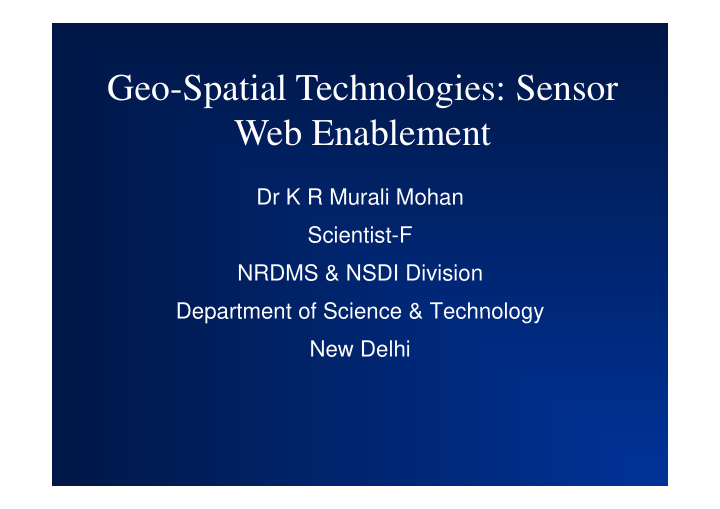



G Geo-Spatial Technologies: Sensor S ti l T h l i S Web Enablement Web Enablement Dr K R Murali Mohan Dr K R Murali Mohan Scientist-F NRDMS & NSDI Division Department of Science & Technology Department of Science & Technology New Delhi
DST initiative: GeoICT Open ended research programme initiated by DST Open ended research programme initiated by DST - 10 research tracks - Sensor Networks & Web Enablement S N t k & W b E bl t - Indian Digital Heritage - 2D & 3D Data capture and applications - Geospatial technology & Applications
Vision of the Sensor Web
Objective of the SN & WE programme • Discovery of sensor systems, observations, and observation processes through web • Determination of a sensor’s capabilities and quality of measurements • Access to sensor parameters that automatically allow Access to sensor parameters that automatically allow software to process and geolocate observations • Retrieval of real-time or time-series observations and coverages in standard encodings i t d d di • Tasking of sensors to acquire observations of interest • • Subscription to and publishing of alerts to be issued by Subscription to and publishing of alerts to be issued by sensors or sensor services based upon certain criteria • Within the SWE initiative, the enablement of such sensor webs is being pursued through the establishment of several encodings for describing sensors and sensor observations, and through several standard interface definitions for web g services.
Why SWE is required ? • It enables various applications like • Intelligent Transport System • Intelligent Transport System • Weather models, environmental monitoring systems, Public safety & Management Public safety & Management • Unified observational systems, maintenance and management t • Standard observational data sets • Efficient management of resources • Create once and use many times • Integration of various MODELS, Geo-spatial data and on-line observational data enables simulation and possible alert generation
Enabling Mechanisms • National Spatial Data Infrastructure • National Spatial Data Infrastructure – Indian Context Indian Context • Availability of Geo-spatial Data • Standards – OGC, ISO • Web technologies have matured • Considerably consistent web infrastructure is in place • Established ICT expertise including sensors • Proactive R&D institutions and people Proactive R&D institutions and people • DST is a member of OGC and Board of Directors
DST initiated case studies • IITMadras, Chennai: Rural Automatic weather station (RWAS) station (RWAS) – 500 in Tamil Nadu – 1200 in Andhra Pradesh 1200 i A dh P d h • Medical applications: Anna University, Chennai • Body Censors: CDAC, Chennai
Recommend
More recommend